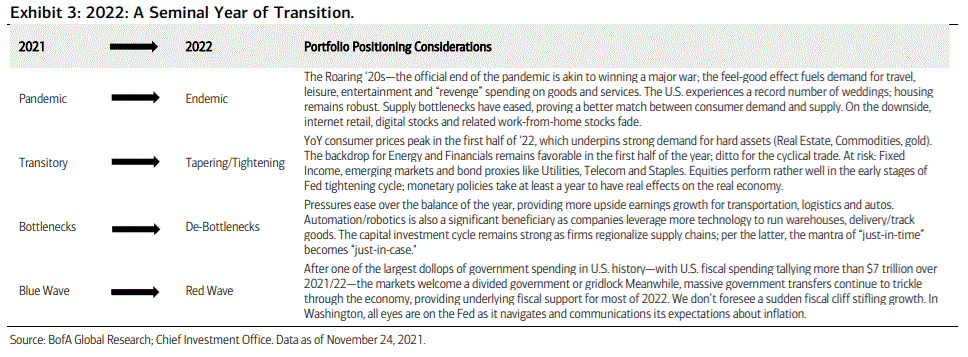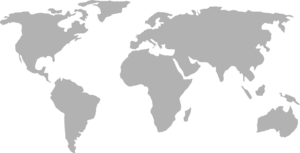Det bliver ikke let at være investor i det nye år, hvis man skal tro Merrill, der mener, at alle de store tendenser i tiden kommer under forandring. Der bliver ikke mangel på forandringer. Det bliver et hårdt år for investorerne med skiftende vindretninger, dvs. med betydelig volatilitet. På fire områder ser Merrill fundamentale forandringer: Pandemien afløses af endemi, dvs. at coronaen ikke forsvinder, men at den kan begrænses, så den ikke ødelægger dagligdagen. Der bliver en strammere pengeplitik. Flaskehalsproblemerne forsvinder stort set. I USA bevæger det politiske pendul sig fra blå til rød, dvs. fra Demokraterne til Republikanerne. Amerikanernes frygt for højere priser kan få afgørende betydning ved Midtvejsvalget til efteråret.
Assessing the Key Moving Parts of 2022
There will be no shortage of change and churn in 2022. Indeed, today’s investment landscape will look significantly different a year from now. Major shifts lie on the horizon that could materially alter the investment terrain and asset prices. Below, we briefly discuss four market-changing dynamics and the attendant implications for portfolios.
Investment Summary
In our view, the coming year will be dominated by major shifts in the investment landscape. Think endemic, tightening, de-bottlenecks and “red wave.” It is going to be choppy and volatile because seminal shifts in the investment landscape are never smooth and linear. Our best case for portfolio positioning considerations is summarized in Exhibit 3.

Pandemic to endemic. All pandemics eventually fade, and coronavirus is expected to be no different. Even with the emergence of the Omicron strain, the pandemic could be relegated to the history books next year if U.S. and global vaccination rates are ramped up—or more of the unvaccinated get jabs and more of the vaccinated get booster shots. Improved antibody treatments and the potential antiviral pills will help assist as well.
Presently, 4.12 billion people worldwide—roughly 54% of the population—have received one dose of the vaccine. On the horizon: endemic coronavirus. In this world, SARS-CoV-2 isn’t completely eradicated—it will survive and likely become endemic, meaning it will always be present in the population. As Dr. Anthony Fauci—Chief Medical Advisor to the President of U.S.—recently noted, “endemicity means a lot more people get vaccinated, a lot more people get boosted, and although you don’t eliminate or eradicate it, that infection is not dominating your life.”3
“Transitory” to tapering to tightening. Heading into 2021, the Street consensus for the first Fed rate hike was sometime in early 2023. But the double-barreled effect of ultraease monetary policies-cum-massive fiscal spending, and the attendant surge in inflationary prices/pressures, has pulled forward the timing of both Fed tapering and tightening—and made mash of Fed-speak of price pressures being “transitory.” Tapering (monthly bond buying program) has begun, while the pivot toward tighter monetary policies will gain significant traction over the balance of 2022. Indeed, BofA Global Research have upped their Fed tightening timetable by two quarters and expect the Fed to start hiking rates in June 2022. The outlook is now for three hikes in 2022, four hikes in 2023, and one in 2024, bringing the Fed funds rate up to 2.0% to 2.25%.
Bottlenecks to de-bottlenecks. Supply chain disruptions have throttled the production of numerous goods, boosted prices for finished/unfinished goods, and have had significant international spillover effects. That said, supply chain bottlenecks are expected to ease over the balance of 2022 as more firms broaden their supplier base and increasingly localize/regionalize their supply chains. Also helping matters: Third-party manufacturers in Asia ramp factory production as vaccination rates climb across the region; port bottlenecks slowly unwind next year; and the pandemic-related surge in demand for manufactured
goods—which helped amplify the severity of bottlenecks—fades.
A blue wave to red wave. As we recently noted, the political tea leaves for the Democrats aren’t looking favorable. Indeed, less than one year out from the 2022 midterm election, the political landscape for Democrats, to say the least, looks rather challenging. Numerous polls speak to the fading popularity of the White House, with voter angst fueled by slower growth and rising inflationary pressures on virtually everything (goods and services).
There’s nothing more politically harmful one year before an election than voter concerns of stagflation—weak growth-cum-rising prices. Per the latter, October’s consumer price index (CPI) year-over-year (YoY) number came in at 6.2%, the biggest gain in consumer prices since 1990. Prices, not jobs, have moved to the political forefront.










